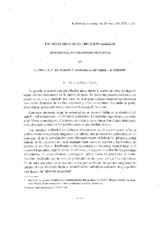Mostrar el registro sencillo del ítem
Polimorfismos bioquímicos en caballos
| dc.contributor.author | Andrés Cara, D.F. de | |
| dc.contributor.author | Álvarez, A. | |
| dc.contributor.author | Garzón Garrido-Espiga, R. | |
| dc.contributor.author | Aguilar, P. | |
| dc.contributor.author | Ariza Arellano, A. | |
| dc.date.accessioned | 2010-04-27T07:39:58Z | |
| dc.date.available | 2010-04-27T07:39:58Z | |
| dc.date.issued | 1979 | |
| dc.identifier.issn | 1885-4494 | |
| dc.identifier.uri | http://hdl.handle.net/10396/3067 | |
| dc.description.abstract | Have been analysed haemoglobin (flb), albumin (Al), esterase (Es-al) and transferrin (Tf) types of 168 horses belonging to thoroughbred (English), Arab, Spanish and Breton breeds and their cross-breeds English-Arab and Spanish-Breton. We have found all the three haemoglobin types (AA, Aa, and aa); the most common was AA type. The lowest frequency was aa, it only appeared in one Spanish horse. Have been found all the three albumin phenotypes (IF, FS" and SS). The most common was FS phenotype, the least was FF which was absent from thorough-bred. The most common allele was Als. Of the seven possible phenotypes of alkaline esterase (Gahne, 1966) have been found four (F, I, Fl and IS). The most common was I phenotype, which was pre-sent in all the investigated breeds. The least common allele was L followed byEsF. Have beend discovered all the six transferrins alleles reported by Braend & Stormont (1964). The most common allele was Tf, followed by TfD. Of the two-try one possible phenotypes have been seen fifteen (DD, DF; DH, DM, DR, FE, FM; F0, FR, HM, HO, HR, and RR). The most common phenotypes were DF and FF; the most rare was DR, which only appeared in ne Spanish horse. Data"s analysis accomplished, we think it is possible to differenciate between light and draught horses. Taking into account results from contingency tables, we are unable to find association between breds and polymorphism of tranferrins (Tf locus display the greatest number of alleles and therefore it would provide the largest information), we don"t dare to play any categorical affirmation from results of the others polymorphisms, and we prefer to wait for the results from polymorphism of acid esterase and prealbumins we are going to investigate and the values of genetic distances. | en |
| dc.description.abstract | Se han estudiado los tipos de hemoglobina (Hb), albúmina (Al), esterasa-alcalina (Es-al) y transferrina (Tf) en 168 caballos pertenecientes a las razas inglesa, árabe, española y bretona y a los cruces anglo-árabe e hispano-bretón. Han aparecido los tres tipos de hemoglobina (AA, Aa y aa) y predomina el tipo AA. El menos frecuente ha sido el aa, que solo se presento en un caballo español. Se han encontrado los tres posibles fenotipos de albúminas (FF, FS, y SS). El mas abundante es el FS, seguido del SS; y el menos frecuente, el FF, el cual falta en los caballos ingleses. Como alelo más frecuente destaca el Als. De los siete fenotipos posibles de esterasa alcalina (Gahne, 1966) se han descubierto cuatro (F, I, Fl e IS). El fenotipo mas frecuente ha sido el I, presente en todas las razas y cruces investigados. Como alelo menos frecuente figura el Es seguido del EsF. Se han revelado los seis alelos de transferrina descritos por Braend y Stormont (1964). El alelo mas frecuente ha sido el TfF, seguido del Tf D. De los 21 fenotipos posibles se vieron 15 (DD, DF, DH, DM, DO, DR, FF, FH, FM, FO, FR, HM, HO, HR y RR). Los fenotipos mas comunes son el DF y el FF. El más raro, el DR, que solo se presento en un caballo español. Realizado el análisis de los datos creemos que se puede distinguir entre poblaciones ligeras y pesadas. Teniendo en cuenta los resultados de las tablas de contingencia, al no encontrar asociación, a ningún nivel de significación entre razas y el polimorfismo de transferrina, que es, de los loci estudiados, el que mayor número de alelos presenta y, como consecuencia, el que mayor información podría aportar, no nos atrevemos a establecer ninguna afirmación categórica a partir de los resultados de los otros polimorfismos y preferimos esperar los resultados de los demás polimorfismos en estudio (Es-acida y prealbúminas) y el conocimiento de las distintas genéticas. | es_ES |
| dc.format.mimetype | application/pdf | es_ES |
| dc.language.iso | spa | es_ES |
| dc.publisher | Universidad de Córdoba, Servicio de Publicaciones | es_ES |
| dc.rights | https://creativecommons.org/licenses/by-nc-nd/4.0/ | es_ES |
| dc.source | Archivos de zootecnia 28 (111), 221-240 (1979) | es_ES |
| dc.subject | Polimorfismo bioquímico | es_ES |
| dc.subject | Caballos | es_ES |
| dc.title | Polimorfismos bioquímicos en caballos | es_ES |
| dc.title.alternative | Biochemical polymorphisms in horses | en |
| dc.type | info:eu-repo/semantics/article | es_ES |
| dc.relation.publisherversion | http://www.uco.es/organiza/servicios/publica/az/az.htm | es_ES |
| dc.rights.accessRights | info:eu-repo/semantics/openAccess | es_ES |

